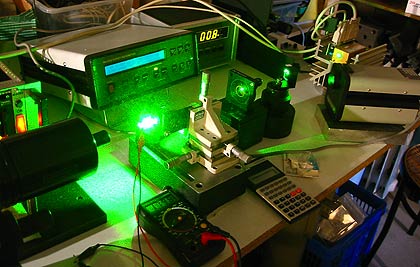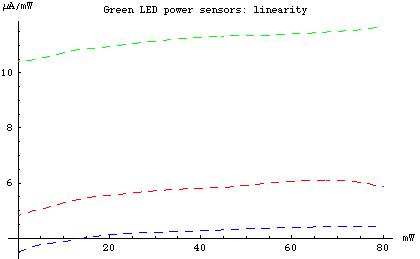
Return to home page
There were reports about using green LEDs to serve as cheap and simple power meter sensors, in particular for 532nm laser pointers. As any semiconductor junction should generate some current when illuminated, there should nothing be wrong with the idea, but reports of accuracies to a few percent are hard to believe - even most professional power meters have an accuracy to this order only, and are very expensive for good reasons. These LEDs have not been designed for this purpose, and thus have no specifications concerning sensitivy, so there is no reason to expect that their sensitivity would be in any sense constant over the brand, their part number, or even the particular production batch.
In order to settle this, I put my new power measurement gadgetry (laser precision meter RK-5720 and chopper head RPK-575; verified to be about 2-3% accurate) to good use and made a setup for precision measurements (yes, there can be good deals on ebay ... just $50 for the whole unit). Since green LEDs from Radio Shack seem to be popular, as they are easily available, I acquired a pair of them during my last trip over to the US.
First a pic of the setup: in the background at far right, a computer stabilized Compass 315M DPSS laser with up to 100mW output, fed into a beam splitter for concurrent power monitoring by the RPK-575 chopper head to the right. The main beam continues through a L/2 waveplate for rotating the polarization. Then comes a 3D stage with micrometer adjustments, it holds the LED under scrutiny, which shines too bright to be visible. To the left there is a precision Scientech calorimeter for occasional independent verification of the power, when the diode is out of beamline.

The adjustment of the LED needs to be quite precise, ie. better than a mm or so, otherwise there will be a sizeable measurement error. At first I tried alignment by hand but couldn't really find the maximim - after aligning via the micrometers the reading went up by 50% or more (I didn't check the influence of the beam diameter, I used a fixed beam diameter of approx. 2mm.). On the other hand, I found that the effect of the rotating the polarization is only in the order of 10%, which is negligible as compared to other factors.
Below are the results. The red and blue curves refer to the two green LEDs from Radio Shack, out of the same package (Radio Shack stock number 276-022, "5mm green LED, 2.1V, 25mA, 6.3mcd", as of August 05). These are all data I know, in particular I don't know model and manufacturer; "custom manufactured in Japan or China" is written on the back, and this can mean anything...and there is no reason why it should stay the same over time. At any rate, even those two diodes from the same batch already differ substantially.

The green line is for some other bright green LED of unknown origin, which happend to be around my parts box - it looks exactly like the Radio Shack diodes but has twice the sensitivity as one of them. All this shows that either with known, and even less with unknown diodes, one cannot hope to make power measurements with any decent accuracy !
One the other hand, once calibrated such diodes might be useful - indeed the linearity is sort of OK up to at least 75mW, which is as far as I checked. This is much better than dedicated photo diodes, which are much more sensitive and so tend to saturate and become non-linear beyond a few mW. One Radio Shack LED varies between 3.6 and 4.4uA/mW, the other between 5 and 6uA/mW, and the random LED between 10.4 and 11.5uA/mW. The drop-off at low power is probably due to increased measurement errors. See the plot below:

So to give some concrete approximate numbers, the Radio Shack diodes have approx 4 and 5.5uA/mW, while the third diode has 11uA/mW. The often-quoted sensitivity of 2.8uA/mW is roughly one-half to one-third of what I have measured, which means that using this number, people would be let to believe to have two or three times the power their pointer actually has. On the other hand, another quoted value of 4.8uA/mW is correct within +/-20%, however only for those two Radio Shack diodes.
Return to home page
Vers 1.1 09/05